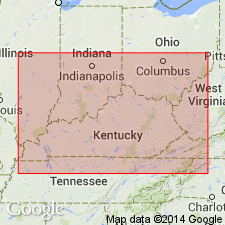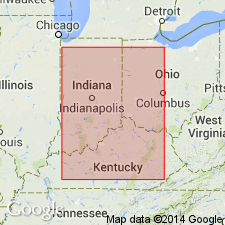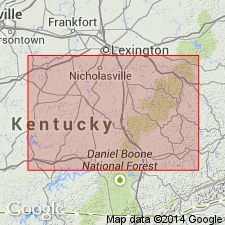
- Usage in publication:
-
- Wildie sandstone member*
- Modifications:
-
- Named
- Dominant lithology:
-
- Siltstone
- Shale
- AAPG geologic province:
-
- Cincinnati arch
Summary:
Named Wildie sandstone member of Warsaw formation. Composed of sandstone that is thick-bedded, very uniformly fine-grained, bluish and of medium hardness. Maximum thickness is 6 ft.
Source: GNU records (USGS DDS-6; Reston GNULEX).

- Usage in publication:
-
- Wildie siltstone member
- Modifications:
-
- Revised
- AAPG geologic province:
-
- Cincinnati arch
Summary:
Wildie sandstone member of Warsaw formation of Butts (1922) revised to Wildie siltstone member of Muldraugh formation. Consists of bedded, fairly resistant siltstone with a subordinate amount of shale in the vicinity of Wildie, KY. Percentage of shale increases away from Wildie. Thickness ranges from 20 to 30 ft. Underlain by Floyds Knob formation; overlain by higher parts of Muldraugh formation. Age is Early Mississippian.
Source: GNU records (USGS DDS-6; Reston GNULEX).

- Usage in publication:
-
- Wildie Siltstone Member*
- Modifications:
-
- Revised
- AAPG geologic province:
-
- Cincinnati arch
Summary:
Wildie siltstone member of Muldraugh formation of Stockdale (1939) revised to Wildie Siltstone Member of Borden Formation. "Near Wildie [Rockcastle Co., KY] the member is made up almost entirely of thick beds of resistant brownish-weathering, greenish-gray siltstone and very fine grained sandstone with shale in thin seams and partings. Along the outcrop a few miles away from the type locality, the siltstone beds decrease in thickness and number and the amount of shale increases so that siltstone forms a minor part of the member. The shale is nonresistant, clayey to silty, in places glauconitic, and mostly greenish gray but locally grayish red and grayish purple. A persistent seam of glauconitic siltstone is present at the base of the unit and another glauconite seam is at the top." Underlain by Halls Gap Member and overlain by Renfro Member of Borden Formation. Age is Early Mississippian.
Source: GNU records (USGS DDS-6; Reston GNULEX).
For more information, please contact Nancy Stamm, Geologic Names Committee Secretary.
Asterisk (*) indicates published by U.S. Geological Survey authors.
"No current usage" (†) implies that a name has been abandoned or has fallen into disuse. Former usage and, if known, replacement name given in parentheses ( ).
Slash (/) indicates name conflicts with nomenclatural guidelines (CSN, 1933; ACSN, 1961, 1970; NACSN, 1983, 2005, 2021). May be explained within brackets ([ ]).

